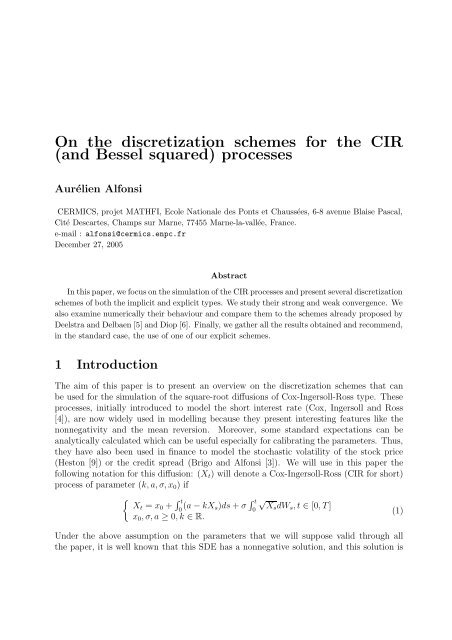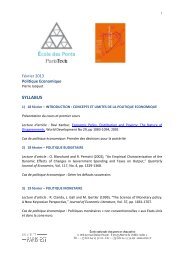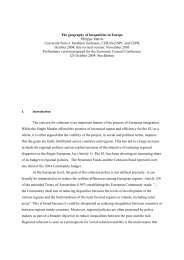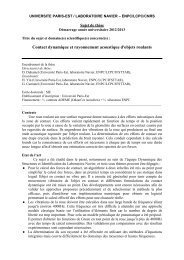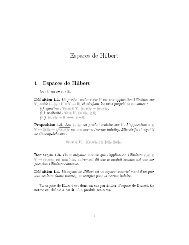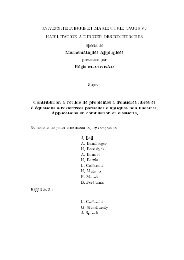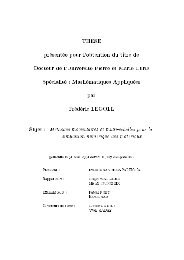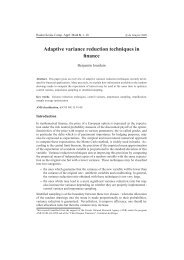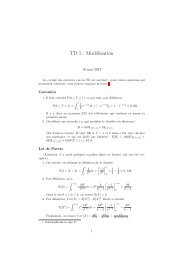(and Bessel squared) processes - Le Cermics - ENPC
(and Bessel squared) processes - Le Cermics - ENPC
(and Bessel squared) processes - Le Cermics - ENPC
- No tags were found...
You also want an ePaper? Increase the reach of your titles
YUMPU automatically turns print PDFs into web optimized ePapers that Google loves.
On the discretization schemes for the CIR(<strong>and</strong> <strong>Bessel</strong> <strong>squared</strong>) <strong>processes</strong>Aurélien AlfonsiCERMICS, projet MATHFI, Ecole Nationale des Ponts et Chaussées, 6-8 avenue Blaise Pascal,Cité Descartes, Champs sur Marne, 77455 Marne-la-vallée, France.e-mail : alfonsi@cermics.enpc.frDecember 27, 2005AbstractIn this paper, we focus on the simulation of the CIR <strong>processes</strong> <strong>and</strong> present several discretizationschemes of both the implicit <strong>and</strong> explicit types. We study their strong <strong>and</strong> weak convergence. Wealso examine numerically their behaviour <strong>and</strong> compare them to the schemes already proposed byDeelstra <strong>and</strong> Delbaen [5] <strong>and</strong> Diop [6]. Finally, we gather all the results obtained <strong>and</strong> recommend,in the st<strong>and</strong>ard case, the use of one of our explicit schemes.1 IntroductionThe aim of this paper is to present an overview on the discretization schemes that canbe used for the simulation of the square-root diffusions of Cox-Ingersoll-Ross type. These<strong>processes</strong>, initially introduced to model the short interest rate (Cox, Ingersoll <strong>and</strong> Ross[4]), are now widely used in modelling because they present interesting features like thenonnegativity <strong>and</strong> the mean reversion. Moreover, some st<strong>and</strong>ard expectations can beanalytically calculated which can be useful especially for calibrating the parameters. Thus,they have also been used in finance to model the stochastic volatility of the stock price(Heston [9]) or the credit spread (Brigo <strong>and</strong> Alfonsi [3]). We will use in this paper thefollowing notation for this diffusion: (X t ) will denote a Cox-Ingersoll-Ross (CIR for short)process of parameter (k, a, σ, x 0 ) if{Xt = x 0 + ∫ t(a − kX 0 s)ds + σ ∫ t √Xs dW0 s , t ∈ [0, T ]x 0 , σ, a ≥ 0, k ∈ R.(1)Under the above assumption on the parameters that we will suppose valid through allthe paper, it is well known that this SDE has a nonnegative solution, <strong>and</strong> this solution is
Discretization schemes for the CIR <strong>processes</strong> 2pathwise unique (see for example Rogers <strong>and</strong> Williams [13]). <strong>Le</strong>t us recall here that underthe assumption (see for example Lamberton <strong>and</strong> Lapeyre [11])2a > σ 2 <strong>and</strong> x 0 > 0 (2)the process is always positive.When k > 0, it is common to define θ = a/k <strong>and</strong> rewrite the SDE dX t = k(θ − X t )dt +σ √ X t dW t . Indeed, θ appears as the asymptotic mean of X t toward which the process isattracted. In practice, this more intuitive parametrization is preferred.In the sequel, (F t , t ≥ 0) will denote the natural filtration of the Brownian motionW , <strong>and</strong> we will consider the regular grid t n i = iT . Except in cases where it is importantnto remind the dependency in n, we will write t i rather than t n i . It is well known thatthe increments of the CIR process are non-central chi-<strong>squared</strong> r<strong>and</strong>om variables that canbe simulated exactly. Thus, we can inductively simulate a r<strong>and</strong>om vector distributedaccording to the law of (X t0 , ..., X tn ) (see Glasserman [7], pp. 120-134). However, the exactsimulation in general requires more time than a simulation with approximation schemes.It may also be restrictive if one wishes to correlate this diffusion with another diffusion viathe Brownian motions as in Brigo <strong>and</strong> Alfonsi [3] where two correlated CIR <strong>processes</strong> areconsidered. At least for both these reasons, studying approximation schemes is relevant.It is important to remark first that the natural way to simulate this process, that is theexplicit Euler-Maruyama schemeˆX t n i+1= ˆX t n i+ T √n (a − k ˆX t n i) + σ ˆX t n i(W ti+1 − W ti )with ˆX t n 0= x 0 can lead to negative values since the Gaussian increment is not boundedfrom below. Thus, this scheme is not well defined. To correct this problem, Deelstra <strong>and</strong>Delbaen [5] have proposed to consider:ˆX n t i+1= ˆX n t i+ T n (a − k ˆX n t i) + σ√ˆXnti1 ˆXn ti >0 (W t i+1− W ti )while Diop proposes in [6]:ˆX t n i+1= | ˆX t n i+ T √n (a − k ˆX t n i) + σ ˆX t n i(W ti+1 − W ti )|.However, we can as proposed in Brigo <strong>and</strong> Alfonsi [3] obtain the positivity using an implicitscheme. More precisely, if we rewrite the CIR process with the posticipated stochastic
Discretization schemes for the CIR <strong>processes</strong> 3integral, we get, since d〈 √ X, W 〉 s = σ 2 ds:X t = x 0 +∫ t0(a − kX s )ds + σ∫ t0√Xs dW s{ ∑= x 0 + lim (a − kX ti+1 ) Tn→∞ n + σ ∑ √Xti+1 (W ti+1 − W ti )i;t i
Discretization schemes for the CIR <strong>processes</strong> 4that has also only one positive root when σ 2 < 4a <strong>and</strong> T n < 2/k− , <strong>and</strong> it gives:⎛√σˆX t n 2i+1= ⎜(W t i+1− W ti ) + ˆXn ti+⎝√√( σ (W 2 t i+1− W ti ) + ˆXn ti) 2 + 4(1 + kT2(1 + kT2n )) a−σ2 /42n 2(4)In this case ˆX t n i+1is still an increasing function of ˆXn tiso that the monotonicity propertyis satisfied. One can wonder whether we can get other schemes looking at the implicitscheme (implicit on the drift <strong>and</strong> the diffusion coefficients) with the SDE satisfied by X α .It is not hard to see that the only two values of α that give a second-degree equation are1 <strong>and</strong> 1/2. The other powers do not lead to analytical formulas <strong>and</strong> require a numericalresolution.It is then interesting to make a rough Taylor expansion of order 1 of these schemes, i.e.we fix ˆX t n i<strong>and</strong> only conserve the terms in T , (W n t i+1− W ti ) <strong>and</strong> (W ti+1 − W ti ) 2 . We getrespectively for the first scheme (3) <strong>and</strong> the second (4):(ˆX t n i+1≈ ˆX t n i1 − k T ) √+ σ ˆX t n ni(W ti+1 − W ti ) + σ 2 /2(W ti+1 − W ti ) 2 + (a − σ 2 /2) T nˆX n t i+1≈ ˆX n t i(1 − k T n)√+ σ ˆX t n i(W ti+1 − W ti ) + σ 2 /4(W ti+1 − W ti ) 2 + (a − σ 2 /4) T nThis indicates us a family of explicit schemes E(λ) for 0 ≤ λ ≤ a − σ 2 /4 that ensurenonnegative values but not the property of monotonicity:( (ˆX t n i+1= 1 − kT ) √)ˆX t n 2ni+ σ(W 2t i+1− W ti )2(1 − kT ) (5)2n+(a − σ 2 /4)T/n + λ[(W ti+1 − W ti ) 2 − T/n].It is well defined for kT/n ≠ 2. The expansion of the scheme (3) corresponds then toλ = σ 2 /4 while the scheme (4) to λ = 0. It is interesting here to notice that the implicitscheme on the square-root <strong>and</strong> the explicit scheme E(0) have the same expansion (up toorder 1) as the Milstein scheme for (1) (which can lead to negative values like the Eulerscheme when k > 0) <strong>and</strong> for k = 0, E(0) is exactly the Milstein scheme. <strong>Le</strong>t us mentionalso that we could have considered as well the schemes obtained by replacing the factor1 − kT by √ 1 − kT/n in (5).2nThis paper aims to get results on the weak <strong>and</strong> strong convergence of these schemes.<strong>Le</strong>t us mention here that Deelstra <strong>and</strong> Deelbaen have proven in [5] a strong convergenceresult for their scheme. Diop also gets a strong convergence result in [6] but under somestrong assumptions on the coefficients. She also obtains a weak convergence rate thatdepends on parameters. We introduce a framework in Section 2 that will allow us to studysimultaneously several schemes presented above. In Section 3, we will thus establish aresult of strong convergence for the schemes that satisfy an hypothesis denoted by (H S ).Tn⎞⎟⎠2.
Discretization schemes for the CIR <strong>processes</strong> 5Then we analyze the weak error in Section 4, establishing a convergence result with a 1/nrate for schemes satisfying an hypothesis denoted by (H W ). Moreover, an expansion of theweak error is given for the schemes E(λ). Section 5 presents numerical results. We studyin particular the strong convergence speed numerically <strong>and</strong> also calculate the computingtime required by the several schemes. All the properties put in evidence by our analysis arelisted in the conclusion, <strong>and</strong> E(0) seems to be the scheme that gathers the most interestingproperties.2 Notations <strong>and</strong> preliminary lemmas2.1 Some results on the CIR process<strong>Le</strong>mma 2.1. The moments of (X t ) t∈[0,T ] are uniformly bounded by a constant that dependsonly on the parameters (k, a, σ, x 0 ), T , <strong>and</strong> the order of the moment p ∈ N ∗ . More precisely,setting ũ p (t, x 0 ) = E[X p t ], there exists smooth functions ũ j,p (t) that depend on (k, a, σ) suchthat:p∑ũ p (t, x 0 ) = ũ j,p (t)x j 0 .j=0Proof: We have ũ 0 (t, x 0 ) = 1 <strong>and</strong> in the case p = 1, ũ 1 (t, x 0 ) = x + ∫ t0 (a − kũ 1(s, x 0 ))dsthan can be solved:ũ 1 (t, x 0 ) = x 0 e −kt + a 1 − e−ktkwith the convention that 1−e−kt= t for k = 0. <strong>Le</strong>t us consider p ≥ 2 <strong>and</strong> assume the resultktrue for 1 ≤ j ≤ p − 1. One has d(ũp(t,x 0))= [ap + 1p(p − dt 2 1)σ2 ]ũ p−1 (t, x 0 ) − kpũ p (t, x 0 ).Hence, we have∫ tũ p (t, x 0 ) = (e −kt )(x p p 0 + [ap + 1 )2 p(p − 1)σ2 ](e ks ) p ũ p−1 (s, x 0 )ds<strong>and</strong> we get the induction relations0∫ t∀j ≤ p − 1, ũ j,p (t) = (e −kt ) p [ap + 1 2 p(p − 1)σ2 ](e ks ) p ũ j,p−1 (s)dsũ p,p (t) = (e −kt ) p .0This gives the desired result, <strong>and</strong> we remark incidentally that ũ j,p (t) can be written as apolynomial of e −kt or t depending on whether we are in the case k ≠ 0 or k = 0. □2.2 Introduction of the notations O(1/n δ ) <strong>and</strong> O(1/n δ )In this section, we introduce L<strong>and</strong>au type notations for sequences of r<strong>and</strong>om variables thatwill considerably simplify formulas later. To allow the multiplication of two O, we suppose
Discretization schemes for the CIR <strong>processes</strong> 6the existence of moments of any order. The results presented here are elementary, <strong>and</strong> willlargely be used later.Definition 2.2. <strong>Le</strong>t us consider a doubly indexed family of r<strong>and</strong>om variables Z = (Z n γ ) n,γwith n ∈ N <strong>and</strong> γ ∈ Γ n a nonempty set. We will say that Z is of order δ ∈ R - <strong>and</strong> usethe notation Z n γ = O(1/nδ ) - if there exists a family of positive r<strong>and</strong>om variables (A n γ ) γ,nthat have moments of any order uniformly bounded (i.e ∀p ∈ N ∗ , ∃κ(A, p) > 0, ∀n ∈N ∗ , supγ∈Γ nE[(A n γ )p ] ≤ κ(A, p) ) <strong>and</strong> such that:|Z n γ | ≤ A n γ/n δThis is clearly equivalent to the following property:∀p ∈ N ∗ , ∃κ(p) > 0, ∀n ∈ N ∗ , supγ∈Γ nE[(n δ |Z n γ |)p ] ≤ κ(p)When in particular the (Z n γ ) γ,n are deterministic, this is equivalent to the boundedness of(n δ Z n γ ) γ,n <strong>and</strong> we use the st<strong>and</strong>ard notation Z n γ = O(1/nδ ).Remarks 2.3. 1. It is obvious but important to observe that Zγ n = O(1/nδ ) implies thatE[Zγ n] = O(1/nδ ).2. Typically we will use in the paper this definition for Γ n = {t 0 , t 1 , .., t n }.3. A simple but fundamental example is W t ni+1− W t ni= O(1/ √ n) which is clear since√ n|Wt ni+1− W t ni| law= |N (0, T )| has moments of any order.Proposition 2.4. If (Zγ n) n∈N,γ∈Γ n<strong>and</strong> (Zγ ′n)′ n∈N,γ ′ ∈Γ ′ are two families such that n Zn γ =O(1/n δ ) <strong>and</strong> Zγ ′n = ), we have:′ O(1/nδ′1) ∀c ∈ R ∗ , cZγ n = O(1/n δ ) 2) ∀d ∈ R, Zγ n /n d = O(1/n δ+d )3) Zγ n + Z γ ′n ) 4) ∀d > 0, (Zγ n ) d = O(1/n dδ )5) Zγ nZ′nγ = )′ O(1/nδ+δ′where the families in 3) <strong>and</strong> 5) are indexed in Γ n × Γ ′ n . In particular, if we have a familyof functions h n : Γ n → Γ ′ n, we have also:3 ′ ) Z n γ + Z ′nh n(γ) = O(1/ninf(δ,δ′) ) 5 ′ ) Z n γ Z ′nh n(γ) = O(1/nδ+δ′ ).Proof : 1) <strong>and</strong> 2) are obvious. To prove 3), let us assume for example that δ ≤ δ ′ .Then, it is not hard to see that Z i ′n = O(1/n δ ). Since a sum of L p r<strong>and</strong>om variables is L p ,we conclude easily. 4) comes immediately from the definition while 5) requires the use ofCauchy-Schwarz inequality to get the boundedness of the moments.□By Jensen’s inequality, we also easily check the following result.<strong>Le</strong>mma 2.5. <strong>Le</strong>t us consider a family (G γ ′) γ ′ ∈Γ ′ n of σ-algebras <strong>and</strong> (Zn γ ) n∈N,γ∈Γ na familyof r<strong>and</strong>om variables such that Z n γ = O(1/nδ ), then E(Z n γ |G γ ′) = O(1/nδ ).
Discretization schemes for the CIR <strong>processes</strong> 8Using once again the Hölder inequality to bound E[( ˆX n t i) p−1 A n i ] from above, have for aconstant C > 0E[( ˆX n t i+1) p ] ≤ E[( ˆX n t i) p ] + C n (E[( ˆX n t i) p ] + 1) = E[( ˆX n t i) p ](1 + C n ) + C n<strong>and</strong> then we easily conclude that E[( ˆX t n i) p ] + 1 ≤ (x p 0 + 1)e C .□Now, we present a quite general framework that includes, as we will see, the implicitscheme (3) <strong>and</strong> the explicit schemes E(λ). The hypotheses that are stated below will beuseful later to get results of strong <strong>and</strong> weak convergence.Hypothesis (H S ) We will say that ( ˆX t n i) satisfies (H S ) if it is a nonnegative adaptedscheme such that:ˆX t n i+1= ˆX t n i+ T √n (a − k ˆX t n i) + σ ˆX t n i(W ti+1 − W ti ) + m n t i+1− m n t i+ O(1/n 3/2 ) (6)where m n t i+1− m n t iis a martingale increment (i.e. E[m n t i+1− m n t i|F ti ] = 0) of order 1:m n t i+1− m n t i= O(1/n). (7)If it is satisfied, we get immediately that ˆX t n i+1≤ ˆX t n i+ |k|T ˆX n n t i+ σ√ˆXnti(W ti+1 − W ti ) +O(1/n) using that |a − k ˆX t n i| ≤ a + |k| ˆX t n i. Therefore, we can apply the <strong>Le</strong>mma 2.6 <strong>and</strong>deduce that ˆX t n i= O(1). We define in that case the discrete martingale (Mt n i) by{ Mnt0= 0(8)Mt n i+1− Mt n i= σ√ˆXnti(W ti+1 − W ti ) + m n t i+1− m n t i.Thanks to Proposition 2.4 <strong>and</strong> Remark 2.3, we getCorollary 2.7. Under hypothesis (H S ), ˆX n t ihas uniformly bounded moments, <strong>and</strong> we have:(M n t i+1− M n t i) 2 = σ 2 ˆXn ti(W ti+1 − W ti ) 2 + O(1/n 3/2 )ˆX n t i+1− ˆX n t i= O(1/ √ n).However, as we will see when studying the weak error, it can be useful to make astronger assumption to get a faster convergence.Hypothesis (H W ) We say that a scheme ( ˆX t n i) satisfies (H W ) if it already satisfies(H S ) <strong>and</strong> moreoverˆX t n i+1= ˆX t n i+ T √n (a − k ˆX t n i) + σ ˆX t n i(W ti+1 − W ti ) + m n t i+1− m n t i+ O(1/n 2 ) (9)E[( ˆX t n i+1− ˆX]t n i) 2 |F ti = σ 2 ˆXn tiT/n + O(1/n 2 ). (10)The absence of term of order 3/2 in (10) <strong>and</strong> the knowledge of the expansion of the scheme(9) up to order 2 play a key role to get a weak error at most proportional to the time step.
Discretization schemes for the CIR <strong>processes</strong> 9Remark 2.8. <strong>Le</strong>t us suppose that there is a function ψ n (x, w) which is even with respectto its second argument w such that:m n t i+1− m n t i= ψ n ( ˆX n t i, (W ti+1 − W ti )) + O(1/n 3/2 ).Then, ( ˆX n t i+1− ˆX n t i) 2 = σ 2 ˆXn ti(W ti+1 − W ti ) 2 + 2σ√ˆXntiψ n ( ˆX n t i, (W ti+1 − W ti ))(W ti+1 − W ti ) +O(1/n 2 ), <strong>and</strong> therefore condition (10) is automatically satified thanks to <strong>Le</strong>mma 2.5.2.4 Study of the expansion of the different schemesIn this section we examine each scheme presented in the introduction <strong>and</strong> our aim is todiscuss whether it satisfies or not Hypotheses (H S ) <strong>and</strong> (H W ) defined before.2.4.1 Expansion of the implicit scheme (3)We assume here that 2a > σ 2 , <strong>and</strong> exp<strong>and</strong> the relation that defines the implicit scheme (3):(ˆX t n 1i+1=2σ 2 (W4(1 + kT/n) 2 ti+1 − W ti ) 2 + 4( ˆX t n i+ (a − σ2)T/n)(1 + kT/n)2√)+2σ(W ti+1 − W ti ) σ 2 (W ti+1 − W ti ) 2 + 4( ˆX t n i+ (a − σ22 )T/n)(1 + kT/n) (11)<strong>Le</strong>t us now observe that√√| σ 2 (W ti+1 − W ti ) 2 + 4( ˆX t n i+ (a − σ22 )T/n)(1 + kT/n) − 2 ˆX t n i(1 + kT/n)|√≤ σ 2 (W ti+1 − W ti ) 2 + 4(a − σ22 )(1 + kT/n)T/n = O(1/√ n), (12)using Proposition 2.4. Thus, we haveˆX n t i+1= 11+kT/n ˆX n t i+1(1+kT/n) 3/2 σ√ˆX t n i(W ti+1 − W ti ) + O(1/n)which gives that ˆX t n i= O(1) using <strong>Le</strong>mma 2.6. Once we know this, we can continue theexpansion thanks to Proposition 2.4 <strong>and</strong> it is not hard to get:whereˆX n t i+1− ˆX n t i= T n (a − k ˆX n t i) + σ22 [(W t i+1− W ti ) 2 − T/n] + ˙ M n t i+1− ˙ M n t i+ O(1/n 2 ) (13)˙ M n t iis a discrete F ti -martingale defined by ˙ M n t 0= 0 <strong>and</strong>√M˙t n i+1= M ˙ t n i+ σ(W ()t i+1− W ti )σ2(1 + kT/n) 2 (W 2 ti+1 − W ti ) 2 + 4 ˆX t n i+ (a − σ22 )T (1 + kT/n).n
Discretization schemes for the CIR <strong>processes</strong> 10Indeed, we have E( ˙ M n t i+1|F ti ) =M˙t n σ √ ∫T∞i+2 √ 2πn(1 + kT/n) 2√xe − x2 σ2 T2−∞ n x2 + 4( ˆX t n i+ (a − σ2)T/n)(1 + kT/n)dx2} {{ }0= ˙ M n t i.Moreover, we have ( M ˙ t n i+1− M ˙ t n i) 2 = σ 2 (W ti+1 − W ti ) 2 ˆXn ti+ O(1/n 2 ) <strong>and</strong> in particularM˙t n i+1− M ˙ t n i= O(1/ √ n). Now, we can define the martingale (m n t i) by√m n t i+1− m n t i= σ22 [(W t i+1− W ti ) 2 − T/n] + M ˙ t n i+1− M ˙ t n i− σ ˆX t n i(W ti+1 − W ti )<strong>and</strong> it is easy from (13) to see that the properties (6) <strong>and</strong> (9) are satisfied. Inequality (12)gives us that M˙t n i+1− M ˙ t n i− σ√ˆXnti(W ti+1 − W ti ) = O(1/n) <strong>and</strong> therefore property (7) issatisfied by m n since σ22 [(W t i+1− W ti ) 2 − T/n] = O(1/n). We have first shown thus that(H S ) is satisfied. Now, using the Proposition 2.4, we get that:( ˆX n t i+1− ˆX n t i) 2 = σ 2 (W ti+1 − W ti ) 2 ˆXn ti+[σ 2 ((W ti+1 − W ti ) 2 − T/n) + 2(a − k ˆX n t i)T/n]( ˙ M n t i+1− ˙ M n t i) + O(1/n 2 )<strong>and</strong> that the term of order 3/2, [σ 2 ((W ti+1 − W ti ) 2 − T/n) + 2(a − k ˆX t n i)T/n]( M ˙ t n i+1− M ˙ t n i),has a null conditional expectation respect to F ti since it can be written as an odd functionrespect to the Brownian increment. This shows that we have (10) <strong>and</strong> (H W ) is also satisfiedby this implicit scheme.2.4.2 Expansion of the implicit scheme (4)<strong>Le</strong>t us assume here that 4a > σ 2 . Exp<strong>and</strong>ing (4), we get:[ ( √ ) 2 (ˆX t n 1 σi+1=24(1 + kT2n )2 2 (W t i+1− W ti ) + ˆX t n i+ 4 1 + kT ) a − σ 2 /4T/n2n 2( √ ) √ ⎤( √ ) 2 (σ σ+ 22 (W t i+1− W ti ) + ˆX t n i2 (W t i+1− W ti ) + ˆX t n i+ 4 1 + kT ) a − σ2 /4 T⎦ .2n 2 nThus, using the inequality x 2 + x √ { 2xx 2 + y ≤2 + y/2 if x > 0for y ≥ 0, we get that0 if x ≤ 0[ (σ √ ) 2 (ˆX t n 1i+1≤(1 + kT2n )2 2 (W t i+1− W ti ) + ˆX t n i+ 1 + kT ) ]a − σ 2 /4T/n2n 2<strong>and</strong> we can therefore apply Proposition 2.6 to deduce that ˆX t n ihas bounded moments.Unfortunately, if we try now to get an expansion of ˆXn tiup to order 3/2 by exp<strong>and</strong>ing the
Discretization schemes for the CIR <strong>processes</strong> 11square-root, we get a term in1 qˆXn tiO(1/n 3/2 ) which is hard to manage. Despite the goodnumerical convergence of this scheme, our approach in this paper did not enable us toobtain theoretical results for it.2.4.3 Expansion of the explicit scheme E(λ)<strong>Le</strong>t us assume here that 4a ≥ σ 2 <strong>and</strong> consider λ ∈ [0, a − σ 2 /4]. Exp<strong>and</strong>ing (5), we getˆX t n i+1− ˆX t n i= (a − k ˆX t n i) T ( ) 2 ( ) 2n + k24 ˆX Tt n i+ kσ2 2 − kT/(2n) Tn 8 (1 − kT/(2n)) 2 n√()+σ ˆX t n σ 2i(W ti+1 − W ti ) +4(1 − kT/(2n)) + λ ((W 2 ti+1 − W ti ) 2 − T/n)√)≤ σ ˆX t n i(W ti+1 − W ti ) +(k − + k2 TˆX n Tt4 n in + O(1/n).We can then apply <strong>Le</strong>mma 2.6 to deduce that ˆX t n i= O(1). We have then an expansionanalogous to that obtained for the implicit scheme, that isˆX t n i+1− ˆX t n i= T √n (a − k ˆX t n i) + σ ˆX t n i(W ti+1 − W ti ) + m n t i+1− m n t i+ O(1/n 2 ) (14)where m n t iis a F ti -martingale defined by m n t 0= 0 <strong>and</strong> m n t i+1− m n t i= ( σ24 + λ)[(W t i+1−W ti ) 2 − T/n]. It is in this case straightforward to see that we have the properties (6) <strong>and</strong>(9) <strong>and</strong> that the martingale increments satisfy (7) <strong>and</strong> (10) thanks to Remark 2.8. Hence,explicit scheme E(λ) fulfills the conditions of (H S ) <strong>and</strong> (H W ).3 Strong convergenceIn all this section, we consider a scheme ( ˆX t n i) that satisfies the hypothesis (H S ). Wewill prove the strong convergence for it, following the method proposed by Deelstra <strong>and</strong>Delbaen [5] that relies on Yamada’s functions. Thus, we first need to build a continuousadapted extension of our scheme in order to use then Itô’s formula. For that purpose, weneed to explicit the O terms <strong>and</strong> first define Zt n i= O(1/n 3/2 ) as:ˆX n t i+1= ˆX n t i+ T n (a − k ˆX n t i) + M n t i+1− M n t i+ Z n t iWe can suppose that Zt n iis F ti -measurable. Indeed, if it were not the case, it would besufficient then to consider the martingale increment˜M n t i+1− ˜M n t i= M n t i+1− M n t i+ Z n t i− E[Z n t i|F ti ]<strong>and</strong> ˜Z t n i= E[Zt n i|F ti ] instead of respectively Mt n i+1− Mt n i<strong>and</strong> Zt n i. Thus, we have ˜M t n i+1−˜M t n i+ ˜Z t n i= Mt n i+1− Mt n i+ Zt n i<strong>and</strong>, thanks to <strong>Le</strong>mma 2.5, we get that ˜Z t n i= O(1/n 3/2 ), <strong>and</strong>also ˜M n t i+1− ˜M n t i= σ√ˆXnti(W ti+1 − W ti ) + O(1/n).
Discretization schemes for the CIR <strong>processes</strong> 12Now, we apply the martingale representation theorem to the martingales {E(m n t i+1|F t )−m n t i, t ∈ [t i , t i+1 ]} to get the existence of an F t -adapted process (Rt n , 0 ≤ t ≤ T ) such thatE(m n t i+1|F t ) − m n t i=∫ tt iR n s dW s.In particular, we know that ∫ tt iRs ndW s = O(1/n) <strong>and</strong> so ( ∫ tt iRs ndW s) 2 = O(1/n 2 ) whichgives us that, for t ∈ [t i , t i+1 ]:∫ tt iE[(R n s ) 2 ]ds = O(1/n 2 ). (15)Now, we are able to build a continuous extension ( ˆX t n, 0 ≤ t ≤ T ) F t-adapted of ourdiscretization scheme. Indeed, we define for t ∈ [t i , t i+1 ]:ˆX t n = ˆX t n i+ (t − t i )(a − k ˆX t n i+ n ∫ t √T Zn t i) + (σ ˆX t n i+ Rs n )dW s .t iThus, naming η(t) the function defined on [0, T ] by η(t) = t i for t ∈ [t i , t i+1 ), we can rewriteour scheme as follows:∫ tˆX t n = x 0 + (a − k ˆX η(s) n + n ∫ tT Zn η(s) (σ√ )ds + ˆXn η(s)+ Rs n )dW s. (16)0<strong>Le</strong>t us now introduce a family of Yamada’s functions (see Karatzas <strong>and</strong> Shreve [10]) ψ ɛ,mparametrized by two positive numbers ɛ <strong>and</strong> m. Since we have ∫ ɛ 1ɛe −σ2 m du = m, thereσ 2 uexists a continuous function ρ ɛ,m with a compact support in ]ɛe −σ2m , ɛ[ such that ρ ɛ,m (x) ≤2for x > 0 <strong>and</strong> ∫ ɛσ 2 xm ɛe −σ2 m ρ ɛ,m (u)du = 1. We then considerψ ɛ,m (x) =∫ |x|∫ y000ρ ɛ,m (u)dudythat can be viewed as a sequence of smooth approximation of x → |x| when m is large <strong>and</strong>ɛ tends to 0. Indeed functions ψ ɛ,m thus satisfies:|x| − ɛ ≤ ψ ɛ,m (x) ≤ |x|, |ψ ɛ,m ′ (x)| ≤ 1, 0 ≤ ψ′′ ɛ,m (x) = ρ ɛ,m(|x|) ≤Following the method used by Deelstra <strong>and</strong> Delbaen [5], we first write<strong>and</strong> then apply Itô’s formula :ψ ɛ,m ( ˆX n t − X t ) =2σ 2 |x|m .| ˆX n t − X t | ≤ ɛ + ψ ɛ,m ( ˆX n t − X t ) (17)∫ t+(kX s − k ˆX n η(s) + n T Zn η(s) )ψ′ ɛ,m ( ˆX n s − X s)ds0∫ t0∫ t(σ√ˆXnη(s)+ R n s − σ √ X s )ψ ′ ɛ,m( ˆX n s − X s )dW s√(σ ˆXn η(s)+ Rs n − σ√ X s ) 2 ψ ɛ,m ′′ ( ˆX s n − X s)ds+ 1 2 0=: I 1 (t, n) + I 2 (t, n) + I 3 (t, n).
Discretization schemes for the CIR <strong>processes</strong> 13The absolute value of the first integral can be bounded using that ‖ψ ′ ɛ,m‖ ∞ ≤ 1 :I 1 (t, n) ≤ |k|∫ tFor the third integral, we have that0(|X s − ˆX n s | + | ˆX n s − ˆX n η(s) |)ds + ∫ t(σ√ˆXnη(s)+ R n s − σ√ X s ) 2 ≤ 2(σ 2 |X s − ˆX n η(s) | + (Rn s )2 )Therefore, using that ψ ′′ɛ,m (x)|x| ≤ 2σ 2 mI 3 (t, n) ≤ 2t mm + 2eσ2 ɛm0nT |Zn η(s) |ds.≤ 2(σ 2 |X s − ˆX n s | + σ2 | ˆX n s − ˆX n η(s) | + (Rn s )2 ). (18)<strong>and</strong> ‖ψ′′ ɛ,m ‖ ∞ ≤ 2eσ2 mσ 2 ɛm∫ t0we get:(| ˆX n s − ˆX n η(s) | + 1 σ 2 (Rn s )2 )ds.Using <strong>Le</strong>mma 2.1, Corollary 2.7 <strong>and</strong> (15), we check that E[I 2 (t, n)] = 0. Now, takingthe expectation in (17), we get∀t ∈ [0, T ], E(| ˆX n t∫ t− X t |) ≤ ɛ + |k|0( )E(| ˆX s n − X s|)ds + 2T m + 2e σ2 mσ 2 ɛm + |k| Cte√ nfor some Cte > 0, using that | ˆX s n − ˆX η(s) n | = O(1/√ n) <strong>and</strong> n T Zn η(s) = O(1/√ n). Gronwall’slemma leads then to[ ( ) ]∀t ∈ [0, T ], E(| ˆX t n − X t |) ≤ e |k|T ɛ + 2T m + 2e σ2 mσ 2 ɛm + |k| Cte√ . (19)nNow, taking m = 14σ 2 ln(n) <strong>and</strong> ɛ = 1/ ln(n), we get thatsup E(| ˆX t n − X t |) = O(1/ ln(n)). (20)0≤t≤TNow, we would like to exchange √ the supremum <strong>and</strong> the expectation. Doob’s inequality[ ∫ √tgives E[ sup |I 2 (s, n)|] ≤ C E (σ ˆXn0 η(s)+ Rs n − σ √ X s ) 2 (ψ ɛ,m( ′ ˆX]s n − X s )) 2 ds . We use0≤s≤tthat ‖ψ ɛ,m ′ ‖ ∞ ≤ 1 <strong>and</strong> the inequality (18), <strong>and</strong> then control each terms thanks to relations(20) <strong>and</strong> (15), <strong>and</strong> observing that | ˆX s n − ˆX η(s) n | = O(1/√ n):E[ sup |I 2 (s, n)|] = O(1/ √ ln(n)).0≤s≤tWe can then use the same controls as before for I 1 <strong>and</strong> I 3 to conclude that()E sup | ˆX t n − X t | = O(1/ √ ln(n)). (21)0≤t≤TWe sum up our results in the proposition that follows.
Discretization schemes for the CIR <strong>processes</strong> 14Proposition 3.1. <strong>Le</strong>t us consider a discretization scheme ( ˆX n ) that satisfies the hypothesis(H S ). Then, there exists a positive constant C depending on T <strong>and</strong> on the parameters(k, a, σ, x 0 ) but not on n such that:4 Weak convergencesup E(| ˆX t n i− X ti |) ≤ C/ ln(n)0≤i≤n()E sup | ˆX t n i− X ti | = C/ √ ln(n).0≤i≤nIn this section, we will establish a result that gives the convergence rate of E[f( ˆX T n )] toE[f(X T )]. We will use the method introduced by Talay <strong>and</strong> Tubaro (1990) to study thatweak error <strong>and</strong> get also a convergence rate in 1/n provided that f is regular enough. Wethus introduce the notation Xtx to denote the CIR process with initial value x, <strong>and</strong> we firstneed to establish the following technical result.Proposition 4.1. <strong>Le</strong>t us consider f : R + → R a C q function with q ≥ 2, such that thereis A > 0 <strong>and</strong> m ≥ q, m ∈ N such that∀x ≥ 0, |f (q) (x)| ≤ A(1 + x m ).Then u : [0, T ] × R + → R defined by u(t, x) = E[f(XT x −t )] has successive derivatives∂x l ∂l′ t u(t, x) for l, l′ ∈ N <strong>and</strong> l + 2l ′ ≤ q, that satisfy the following property:∃C > 0, ∀(t, x) ∈ [0, T ] × R + ,maxl+2l ′ ≤q |∂l x∂ l′t u(t, x)| ≤ C(1 + x m+q+l′ ) (22)<strong>and</strong> is a classical solution of the PDE:{∂t u(t, x) + (a − kx)∂ x u(t, x) + σ22 x∂2 xu(t, x) = 0u(T, x) = f(x).(23)More generally, let us assume that (f θ , θ ∈ Θ) is a family of C q functions with q ≥ 2, suchthat there is A > 0 <strong>and</strong> m ≥ q, m ∈ N such that∀θ ∈ Θ, ∀x ≥ 0, |f (q)θ(x)| ≤ A(1 + x m ) <strong>and</strong> ∀l < q, |f (l) (0)| ≤ A. (24)For 0 ≤ τ ≤ T , we consider u θ,τ (t, x) = E[f θ (Xτ−t x )] for 0 ≤ t ≤ τ <strong>and</strong> x ≥ 0. Then thereis a constant C > 0 that does not depend on τ <strong>and</strong> θ such thatθ∀θ ∈ Θ, τ ∈ [0, T ], ∀(t, x) ∈ [0, τ] × R + ,maxl+2l ′ ≤q |∂l x ∂l′ t u θ,τ(t, x)| ≤ C(1 + x m+q+l′ ) (25)The proof of this proposition, mainly based on the analytical formula available for thetransition density of the CIR process is made in the Appendix A.We are now able to prove the main results of this section:
Discretization schemes for the CIR <strong>processes</strong> 15Proposition 4.2. <strong>Le</strong>t f : R + → R be a C 4 function such that ∃A, m > 0, ∀x ≥ 0, |f (4) (x)| ≤A(1 + x m ). <strong>Le</strong>t us suppose moreover that the scheme ( ˆX n ) satisfies the hypothesis (H W ).Then, the weak error is in 1/n:E[f( ˆX n T )] = E[f(X T )] + O(1/n).More generally, if (f θ , θ ∈ Θ) is a family of C 4 functions satisfying condition (24) for q = 4,E[f θ ( ˆX n t n j )] = E[f θ(X t nj)] + O(1/n)where O(1/n) has to be understood in the sense of Definition 2.2 with (θ, t n j ) ∈ Γ n =Θ × {t n 0, ..., t n n}.Proof :We have E[f( ˆX n T )] = E[u(T, ˆX n T )] <strong>and</strong> E[f(X T )] = u(0, x 0 ) so that:E[f( ˆX T n )] − E[f(X T )] = E[u(T, ˆX∑n−1T n ) − u(0, x 0 )] = E[u(t i+1 , ˆX t n i+1) − u(t i , ˆX t n i)].<strong>Le</strong>t us consider (t, x) <strong>and</strong> (s, y) in [0, T ] × R + . We can apply the Taylor formula tot ↦→ u(t, y) up to order 2 <strong>and</strong> get:∫ 1u(s, y) = u(t, y) + (s − t)∂ t u(t, y) + (s − t) 2 (1 − τ)∂t 2 u(t + τ(s − t), y)dτ.Now, we apply Taylor formula to y ↦→ u(t, y) <strong>and</strong> y ↦→ ∂ t u(t, y) <strong>and</strong> we finally getu(s, y) =∑0≤l+2l ′
Discretization schemes for the CIR <strong>processes</strong> 16Now we exp<strong>and</strong> the powers of ( ˆX n t i+1− ˆX n t i) up to order 2 using the Hypothesis (H W ):ˆX t n i+1− ˆX t n i= T √n (a − k ˆX t n i) + σ ˆX t n i(W ti+1 − W ti ) + m n t i+1− m n t i+ O(1/n 2 )( ˆX n t i+1− ˆX n t i) 3 = σ 3 ( ˆX n t i) 3/2 (W ti+1 − W ti ) 3 + O(1/n 2 )Therefore, we get that[E ˆXn ti+1− ˆX∣ ]t n iF tiE[( ˆX t n i+1− ˆX]t n i) 3 |F ti<strong>and</strong> according to (10), E[( ˆX t n i+1− ˆX]t n i) 2 |F ti= T n (a − k ˆX n t i) + O(1/n 2 )= O(1/n 2 )= σ 2 ˆXn tiT/n + O(1/n 2 ).The bound (22) <strong>and</strong> <strong>Le</strong>mma 2.6 ensure that ∂x∂ l t l′ u(t i , ˆX t n i) = O(1) for l + 2l ′ < 4. Thus,using <strong>Le</strong>mma 2.5, we can deduce from (26) :[u(t i+1 , ˆX t n i+1) − u(t i , ˆX]t n i) |F tiE= ∑0
Discretization schemes for the CIR <strong>processes</strong> 17Remark 4.3. We desired to get a weak error in 1/n as in the case of the Euler scheme forstochastic differential equations with coefficients regular enough (C 4 <strong>and</strong> bounded derivatives).Using the argument of Talay <strong>and</strong> Tubaro, we need then a control on u(t i+1 , ˆX n t i+1) −u(t i , ˆX t n i) up to order 2. This is why we assume to know the relation (9) between ˆX t n i+1<strong>and</strong>ˆX t n iup to order 2. Exp<strong>and</strong>ing u(t i+1 , ˆX t n i+1) − u(t i , ˆX t n i), we see that the term of order 1/2has a null expectation, the term of order 1/n is null since u solves the PDE (23), but weneed to require condition (10) so that the term of order 3/2 has a null expectation. If wehad only assumed that the scheme satisfies (H S ), we would have obtained a weak error in1/ √ n.Now, we would like to exp<strong>and</strong> further the weak error, in particular to justify the usethe Romberg method that mainly relies on the following remark: if we know that there isc 1 ∈ R such that E[f( ˆX T n)] = E[f(X T )] + c 1 /n + O(1/n 2 2n), then 2E[f( ˆX T )] − E[f( ˆX T n)] =E[f(X T )] + O(1/n 2 ) converges thus faster toward the desired expectation. If we want toadapt the previous proof, we see that we need to add the following assumptions to get aweak error up to order ν ∈ N ∗ :• f is regular enough (C 4ν ) <strong>and</strong> its derivatives have a polynomial growth.• We know the relation between ˆX n t i+1<strong>and</strong> ˆX n t iup to order ν + 1.Moreover, if we wish to have as for the Euler scheme an error that exp<strong>and</strong>s only on theinteger orders: E[f( ˆX n T )] = E[f(X T )] + c 1 /n + c 2 /n 2 + .. + c ν−1 /n ν−1 + O(1/n ν ), we needto make assumptions of the same kind as (10) for any power of ( ˆX n t i +1 − ˆX n t i) to get termsof order “integer + one half” with null expectation. However these assumptions would behardly readable, <strong>and</strong> practically, they would be clearly satisfied only by the explicit schemesE(λ). That’s why we prefer to state here directly the result for the explicit schemes E(λ).Proposition 4.4. <strong>Le</strong>t ν ∈ N ∗ <strong>and</strong> f : R + → R that we suppose C ∞ <strong>and</strong> such that ∀q, ∃A q >0, m q ∈ N, |f (q) (x)| ≤ A q (1 + x mq ). <strong>Le</strong>t ( ˆX n ) be the explicit scheme E(λ) with 0 ≤ λ ≤a − σ 2 /4. Then, the weak error has an expansion up to order ν:E[f( ˆX n T )] = E[f(X T )] + c 1 /n + c 2 /n 2 + .. + c ν−1 /n ν−1 + O(1/n ν )where c 1 = T ∫ T0 E[ψ E(λ)(t, X t )]dt with ψ E(λ) defined below in (28).Proof : With the same argument as in Proposition 4.2, first using the Taylor expansionrespect to t <strong>and</strong> then to x, we get that there is C(ν) > 0 <strong>and</strong> M(ν) ∈ N:∑u(s, y) −∂x l ∣ ∂l′ t u(t, x)(s − (y − x) lt)l′ l!l ′ ! ∣0≤l+2l ′
Discretization schemes for the CIR <strong>processes</strong> 18Similarly, we get thatu(t i+1 , ˆX n t i+1) − u(t i , ˆX n t i) =∑0
Discretization schemes for the CIR <strong>processes</strong> 19=∑l+2l ′ ≤2j
Discretization schemes for the CIR <strong>processes</strong> 205 Numerical resultsIn this section, we will analyze numerically the convergence of the discretization schemes.For the theoritical study, an interesting feature of the implicit schemes (3) <strong>and</strong> (4) <strong>and</strong> ofthe explicit schemes E(λ), is their “automatic” nonnegativity for the following parameters:Scheme Condition on (a, σ)Implicit (3) σ 2 ≤ 2aImplicit (4) σ 2 ≤ 4aE(λ) 0 ≤ λ ≤ a − σ 2 /4(30)Indeed, contrary to the schemes using a reflection technique as those proposed by Deelstra-Delbaen or Diop, there is no need to control the reflection. However, we can use thefollowing trick to extend schemes (3), (4) <strong>and</strong> E(λ) to all the values of the parameters(k, a, σ):• For the implicit schemes which are defined with second-degree polynomials, we willset ˆX n t i+1= 0 when the discriminant is negative <strong>and</strong> else use formulas (3) <strong>and</strong> (4).• For the explicit schemes E(λ), we simply define ˆX n t i+1as the positive part of theleft-h<strong>and</strong> side of (5)We will use these extensions when needed for the simulations presented in this section.5.1 Numerical study of the strong convergenceIn this paragraph we present a numerical analysis of the strong convergence of variousschemes. It does not seem possible to compute the limit process on the same probabilityspace, <strong>and</strong> we overcome this difficulty using the following lemma that says that it is sufficientto study the difference between the values obtained with a scheme for a given timestep <strong>and</strong> the ones obtained with the same scheme <strong>and</strong> a time step twice smaller. <strong>Le</strong>t usrecall here that t i n = iT/n = t2i 2n .<strong>Le</strong>mma 5.1. <strong>Le</strong>t us consider a scheme ( ˆX t n i) that converges toward a continuous processX t in the following sense: []E sup0≤i≤n| ˆX t n − X ni t ni| −→ 0. (31)n→∞Then, for any α > 0 <strong>and</strong> β ≥ 0,[] [E sup0≤i≤n| ˆX t n (ln n)β− X ni t ni| = O( ) ⇐⇒ E supn 0≤i≤n| ˆX n αt n i−2n ˆXt 2n2i](ln n)β| = O( ).n αThe condition (31) has been established in this paper for the explicit schemes E(λ) <strong>and</strong>for the implicit scheme (3) <strong>and</strong> it has also been proved for the scheme of Deelstra-Delbaen[5]. Under some restrictive conditions of the parameters, the scheme proposed by Diopconverges with a 1/ √ n rate [6]. For the other parameters <strong>and</strong> for the Implicit scheme
Discretization schemes for the CIR <strong>processes</strong> 21on the square-root (4), we can check numerically the condition (31) doing the comparisonwith a scheme on which this comparison has been proved. []Proof of the <strong>Le</strong>mma. If there is K > 0 such that ∀n ∈ N ∗ , E sup0≤i≤n| ˆX t n (ln− X n n)βi t ni| ≤ K ,n αthen [] ( )E sup0≤i≤n| ˆX t n 2n (ln n)β(ln n + ln 2)β ′ (ln n)β− ˆX ni t| ≤ K + ≤ K .2n2in α (2n) α n αReciprocally, since sup0≤i≤n| ˆX t n − X ni t ni| ≤[]get E sup0≤i≤n| ˆX ∑t n − X ni t ni| ≤ K l k=0[]E sup0≤i≤n| ˆX t n − X ni t ni| ≤ Kl ∑k=0sup0≤i≤n(ln n+k ln 2) β(2 k n) α + E∞∑k=0| ˆX n −t 2k n2 k i[sup |0≤i≤n2n ˆXt 2k+1 n2 k+1 i2n ˆX − Xt 2l+1 n t ni|2 l+1 i(ln n) β + (k ln 2) β′(ln n)βC β ≤ K(2 k n) α n α2n| + sup | ˆX − X0≤i≤nt 2l+1 n t ni|, we2 l+1 i]<strong>and</strong> with l → ∞,for some constant K ′ > 0, using that ∑ ∞k=0 kβ /2 k < ∞.□Now for[the numerical study, ] we consider the st<strong>and</strong>ard time interval [0, 1] (T = 1) <strong>and</strong>set S n = E sup0≤i≤n| ˆX t n 2n− ˆX | . The figures below show the convergence of S ni t 2nn in function2iof the time-step 1/n for different parameters. <strong>Le</strong>t us first observe that the implicit scheme(4) <strong>and</strong> the explicit scheme E(0) give errors smaller than the others, for all the values ofthe parameters tested. Which is also interesting <strong>and</strong> nontrivial is that the behaviour ofthe convergence depends on the parameters.We notice that for the case 2a > σ 2 the schemes (4) <strong>and</strong> E(0) present an error whichlooks linear respect to the time-step while the others give a square-root shape (see Fig. 1).This is not totally surprising because we have seen that these schemes correspond to theMilstein expansion, <strong>and</strong> we also know that under this hypothesis, X t never reaches 0 sothat the non-lipschitzian behaviour of the square-root is less important.When 2a < σ 2 < 4a, the schemes (3), E(σ 2 /8), E(σ 2 /4), Deelstra-Delbaen <strong>and</strong> Diop,S n still has a square-root behaviour (see Fig. 2). Finally, let us mention that for the lastcase σ 2 > 4a, the schemes (4) <strong>and</strong> E(0) still give the smaller value of S n . However, wehave to say that when σ 2 >> 4a, the convergence is really slow.Lastly, concerning the impact of λ for the explicit schemes E(λ), we see (Fig. 1 <strong>and</strong> 2)that λ = σ 2 /4 is the parameter that gives a strong convergence analogous to the schemesof Diop, Deelstra-Delbaen <strong>and</strong> implicit (3); <strong>and</strong> the value of S n for E(σ 2 /8) is as one canexpect between those of E(0) <strong>and</strong> E(σ 2 /4).To get an idea of the speed of convergence in function of the parameters, we postulatethat S n ∼ C/n α with α > 0· Thanks to the lemma, this is equivalent to a strongconvergence speed in 1/n α . To estimate α, we remark thatlog 10 (S n ) − log 10 (S 10n ) −→n→+∞α,<strong>and</strong> we have reported log 10 (S n ) − log 10 (S 10n ) for n = 200 in Figure 3. We have plotted theresult in function of the parameter σ 2 /(2a) since it is the one that plays a key role. This
Discretization schemes for the CIR <strong>processes</strong> 220.0280.024Imp (3), D-D, Diop <strong>and</strong> E(σ 2 /4)0.0200.0160.012E(σ 2 /8)0.008rag replacements0.004E(0)Imp (4)0.0000.000 0.001 0.002 0.003 0.004 0.005 0.006 0.007 0.008 0.009 0.010Figure 1: S n in function of the time-step 1/n for x 0 = 1, k = 1, a = 1 <strong>and</strong> σ = 1.0.120.10Imp (3), D-D, Diop <strong>and</strong> E(σ 2 /4)0.080.06E(σ 2 /8)0.04rag replacements0.02E(0)Imp (4)0.000.000 0.001 0.002 0.003 0.004 0.005 0.006 0.007 0.008 0.009 0.010Figure 2: S n in function of the time-step 1/n for x 0 = 1, k = 1, a = 1 <strong>and</strong> σ = √ 3.
Discretization schemes for the CIR <strong>processes</strong> 231.00.9Imp (4)E(0)0.80.70.60.5Imp (3), D-D, Diop, E(σ 2 /8) <strong>and</strong> E(σ 2 /4)0.40.3rag replacements0.20.2 0.6 1.0 1.4 1.8 2.2 2.6 3.0Figure 3: Speed convergence of S n : estimation of the α parameter in function of σ 2 /(2a) forx 0 = 1, k = 1 <strong>and</strong> a = 1.can be understood easily with a time-scaling. For the schemes (4) <strong>and</strong> E(0), the estimatedα is close to 1 for σ 2 < 2a <strong>and</strong> decreases from 1 to 1/2 for 2a < σ 2 < 4a while for theother schemes, the estimated value of α is close to 1/2 for σ 2 < 4a. Intuitively, we canunderst<strong>and</strong> this decrease because for σ 2 > 2a, X t can reach the origin, <strong>and</strong> a non negligibletime is spent in the neighbourhood of 0 where the square root is non Lipschitz. Obviously,the speed of convergence may have a more complicated form than the one postulated, butour method gives nonetheless a good idea of its behaviour.5.2 Numerical study of the weak convergenceWe have plotted in figures 4,5,6 <strong>and</strong> 7, for fixed parameters of the CIR process, the approximationgiven by the scheme or a Romberg extrapolation of the expected value E[f(X 1 )]for the function f(x) = 5+3x4 . This function has been chosen to be sensitive to variation2+5xfor large <strong>and</strong> small values so that it catches the defaults of the schemes near 0 <strong>and</strong> ∞. Wehave taken two sets of parameters that illustrate the cases σ 2 ≤ 2a <strong>and</strong> 2a ≤ σ 2 ≤ 4a.
Discretization schemes for the CIR <strong>processes</strong> 24Implicit (3) Implicit (4) Diop Deelstra-Delbaen E(0) E(σ 2 /4) Exactσ = 1 72 64 65 67 67 68 668σ = √ 2 77 64 67 67 66 70 1092Table 1: Simulation time (in s) for 10 6 paths with a time step equal to 10 −3 <strong>and</strong> parametersk = 1, a = 1 <strong>and</strong> x 0 = 1.<strong>Le</strong>t us recall here that we have proved here the O(1/n) convergence only for regularfunctions <strong>and</strong> for the schemes satisfying (H W ), that is (3) with σ 2 < 2a <strong>and</strong> E(λ) with0 ≤ λ ≤ a − σ 2 /4. What comes out from the computations (see Figures 4 <strong>and</strong> 5) is thatfor the small values of σ (σ 2 ≤ 2a, Fig. 4) all the schemes seem to have a behaviour inO(1/n) while for the large values (σ 2 > 2a, Fig. 5), only the Explicit schemes <strong>and</strong> theDeelstra-Delbaen scheme give shapes compatible with a behaviour in in O(1/n). On thecontrary, the scheme of Diop shows clearly a root shape while the implicit schemes (3) <strong>and</strong>(4) seem to converge a little bit slower than K/n.Concerning the Romberg method to calculate E(f( ˆX 1 )), the figure 6 show that in theboth cases σ 2 ≤ 2a <strong>and</strong> σ 2 > 2a, Diop’s <strong>and</strong> implicit schemes (3) <strong>and</strong> (4) do not show aquadratic convergence. As expected, Explicit schemes have a quadratic shape in all thecases even if, strictly speaking, we have not proved the speed convergence observed forE(σ 2 /8), k = 1, a = 1 <strong>and</strong> σ = √ 3 since λ = σ 2 /8 > a − σ 2 /4. Concerning the Deelstra-Delbaen scheme, let us first say that for large time-steps, negative values may be frequentwhich explains the strange behaviour observed. However, for time-steps small enough, theconvergence seems compatible with a quadratic convergence.5.3 Computation time required by the schemesIn this paragraph we compare the time required by the schemes <strong>and</strong> the exact method tosimulate 10 6 paths with a time step equal to 10 −3 on the time interval [0, 1] (see Table1). Concerning the exact simulation of the increment of the CIR process, we have usedthe method proposed by Glasserman in [7] (see p. 120-128). As we could expect, thismethod is more time-consuming (up to a factor 10). Thus, it should be used to computeexpectations that depend on the values of the process (X t ) at a few fixed times. On thecontrary, for expectations that depends on all the path (such as integrals), discretizationschemes should be preferred. As we see in Table 1, the time required by the schemespresented are of the same order. <strong>Le</strong>t us mention here that for the implicit scheme (4), onehas to be careful <strong>and</strong> store at each step the value of√ˆXntiso that only one square-root hasto be computed at each time step.
Discretization schemes for the CIR <strong>processes</strong> 251.5051.501E(σ 2 /8)E(0)1.4971.4931.489Imp (3)D-DDiop1.4851.481rag replacements1.4771.4731.469Imp (4)1.4650.00 0.01 0.02 0.03 0.04 0.05 0.06 0.07 0.08 0.09 0.10Figure 4: E(f(ˆX2n5+3x41 )) in function of 1/n with f(x) =2+5x for x 0 = 0, k = 1, a = 1 <strong>and</strong> σ = 1.2.902.86Imp (3)E(σ 2 /8)E(0)2.82rag replacementsD-DDiopImp (3)Imp (4)E(0)E(σ 2 /8)2.782.742.702.662.622.58DiopD-D2.54Imp (4)2.500.00 0.01 0.02 0.03 0.04 0.05 0.06 0.07 0.08 0.09 0.10Figure 5: E(f(ˆX2n5+3x41 )) in function of 1/n with f(x) =2+5x for x 0 = 0, k = 1, a = 1 <strong>and</strong> σ = √ 3.
Discretization schemes for the CIR <strong>processes</strong> 261.491Imp (3)Diop1.4891.4871.485D-Drag replacements1.4831.481E(0)Imp (4)E(σ 2 /8)1.4790.00 0.01 0.02 0.03 0.04 0.05 0.06 0.07 0.08 0.09 0.10Figure 6: 2E(f( ˆX2n1 )) − E(f( ˆX 1 n)) in function of 1/n with f(x) = (5 + 3x4 )/(2 + 5x) for x 0 = 0,k = 1, a = 1 <strong>and</strong> σ = 1.2.79002.7689DiopImp (3)2.7478rag replacementsD-DDiopImp (3)Imp (4)E(0)2.72672.70562.68442.6633D-DE(σ 2 /8)2.6422Imp (4)E(σ 2 /8)E(0)2.62112.60000.00 0.01 0.02 0.03 0.04 0.05 0.06 0.07 0.08 0.09 0.10Figure 7: 2E(f( ˆX2n1 )) − E(f( ˆX 1 n)) in function of 1/n with f(x) = (5 + 3x4 )/(2 + 5x) for x 0 = 0,k = 1, a = 1 <strong>and</strong> σ = √ 3.
Discretization schemes for the CIR <strong>processes</strong> 27Implicit (3),σ 2 ≤ 2aImplicit (4),σ 2 ≤ 4aDiopDeelstraDelbaenE(0),σ 2 ≤ 4aNonnegativity Y Y Y N Y YMonotonicity Y Y N N N NStrong CV Y ? Y ∗ Y Y YWeak CV rate in 1/n Y ? Y ∗ ? Y YWeak error expansion ? ? ? ? Y YE(λ), 0 < λ,λ ≤ a − σ 2 /46 ConclusionTable 2: Theoretical resultsWe have sum up in Table 2 the theoretical results obtained in this paper <strong>and</strong> those ofDiop, Deelstra <strong>and</strong> Delbaen [6, 5]. We first point out which scheme satisfy the algebraicproperties of positivity <strong>and</strong> monotonicity. Then, we examine among the several schemeswhether it has been proved• a result of strong convergence,• a weak convergence rate in 1/n,• an expansion of the weak error along the powers of 1/n.The star (Y ∗ ) means that the result has been established under some assumption on theparameters while the question mark indicates that no result has been shown yet. <strong>Le</strong>t usmention here that Diop in [6] has also obtained a strong convergence speed in 1/ √ n undersome restrictive conditions on parameters. Table 3 presents the results of the numericaltests of Section 5.All these results tend to show that the explicit scheme E(0) is the one that gathers themost interesting properties. Moreover, it is really easy to implement <strong>and</strong> is not more timeconsuming than the other schemes. That is why in the general case, it is recommended touse this scheme, at least for σ 2 ≤ 4a.As a further work, it would be interesting to get an accurate mathematical study onthe dependence of the strong convergence of E(0) on σ2(see Fig. 3). It would be also2ainteresting to study the behaviour of the convergence of the various schemes for large valuesof σ, (σ 2 ≥ 4a). Since none of the scheme studied in this paper seems to be efficient forthese large values of σ, designing a relevant scheme appears to be an interesting challenge.Lastly, in a different direction, it would be nice to relax the condition of regularity on f forthe weak error <strong>and</strong> prove estimates on the cumulated distribution function <strong>and</strong> the densityof X T , as in Bally <strong>and</strong> Talay [1, 2] or more recently Guyon [8].Acknowledgement. I am grateful to Benjamin Jourdain (<strong>ENPC</strong>-CERMICS) forhis numerous <strong>and</strong> helpful comments. I also thank Chalinène Bassinah (Paris 13-InstitutGalilée) for having double checked some numerical results.
Discretization schemes for the CIR <strong>processes</strong> 28σ 2 ∈ [0, 2a]Implicit (3)Implicit (4)DiopDeelstraDelbaenStrong CV order ≈ 1/2 ≈ 1 ≈ 1/2 ≈ 1/2 ≈ 1 ≈ 1/2Weak CV rate in 1/n Y Y Y Y Y YRomberg in 1/n 2 N N N Y Y YE(0)E(λ), 0 < λ,λ ≤ a − σ 2 /4σ 2 ∈ [2a, 4a]Strong CV order ≈ 1/2 1/2 ≈ 1/2 ≈ 1/2 1/2 ≈ 1/2Weak CV rate in 1/n ? ? N Y Y YRomberg in 1/n 2 N N N Y? Y YTable 3: Numerical resultsA Proof of the Proposition 4.1We will focus for sake of simplicity on the case of one function <strong>and</strong> one time T beforeexplaining how to extend the results to the case of a family of functions that satisfy (24).We will first provemax0≤l≤q |∂l xu(t, x)| ≤ C(1 + x q+m ) (32)for some constant C > 0, <strong>and</strong> then (23), so that (22) will outcome automatically by aninduction on l ′ , using that for l ′ ≥ 1 such that l + 2l ′ ≤ q,()∂x l ∂l′ t u(t, x) = −∂l x (a − kx)∂ x ∂ l′ −1t u(t, x) + σ22 x∂2 −1x ∂l′ t u(t, x)= − σ22 x∂l+2 x∂ l′ −1t u(t, x) − (l σ22 + a − kx)∂l+1 x∂ l′ −1tu(t, x) + lk∂x∂ l l′ −1u(t, x).<strong>Le</strong>t us set ũ(t, x) = u(T − t, x) = E(f(Xt x )). By <strong>Le</strong>mma 2.1, (32) holds for f(x) = x p(p ∈ N) <strong>and</strong> therefore for any polynomial. Now, using the decomposition f(x) = f(x) −P (x) + P (x) with P (x) = ∑ ql=0 f (l) (0)x l /l!, we deduce that it is enough to prove (32) forf ∈ C q such that |f(x)| ≤ A(1 + x m ) <strong>and</strong> f (l) (0) = 0 for l ≤ q.Integrating successively, we get easily that |f (l) (x)| ≤ A(1 + x m+q−l ) <strong>and</strong> so, ∀ l ≤ q,|f (l) (x)| ≤ A(1 + x m+q ). The density of Xt x is known <strong>and</strong> is given by:tp(t, x, z) =∞∑ e −λtx/2 (λ t x/2) ii=0i!c t /2Γ(i + v/2)( ct z) i−1+v/2e−c tz/22
Discretization schemes for the CIR <strong>processes</strong> 29where c t =We have for t > 0:where4k, v = σ 2 (1−e −kt ) 4a/σ2 <strong>and</strong> λ t = c t e −kt . <strong>Le</strong>t us remark here thatI i (f, c t ) =⎧4k⎨ , k > 0σ 2 4c t ≥ c min := σ⎩, k = 02 T4|k|, k < 0.σ 2 (e |k|T −1)ũ(t, x) =∫ ∞0∞∑ e −λtx/2 (λ t x/2) iI i (f, c t )i!i=0c t /2f(z)Γ(i + v/2)( ct z) i−1+v/2e−c tz/2 dz.2Since for l ≤ q, |f (l) (z)| ≤ A(1 + z m+q ), we have( ( ) )m+q 2∀i ∈ N, |I i (f (l) Γ(i + m + q + v/2), c t )| ≤ A 1 +. (33)c t Γ(i + v/2)Taking l = 0, the convergence of the above series is ensured. Derivating successively in x,we get that for l ≤ q,∀t ∈ (0, T ], x ∈ R + , ∂ l xũ(t, x) =∞∑ e −λtx/2 (λ t x/2) i∆ li!t(I i (f, c t )) (34)i=0where ∆ t : R N → R N is an the operator defined on sequences (I i ) i≥0 ∈ R N by ∆ t (I i ) =λ t(I 2 i+1 − I i ) = e−kt c 2 t(I i+1 − I i ). <strong>Le</strong>t us remark now that, since f (l−1) (0) = 0, an integrationby part gives for 0 < l ≤ q <strong>and</strong> i ≥ 1I i (f (l) , c t ) =∫ ∞−0∫ ∞0f (l−1) (c t /2) 2(z)Γ(i + v/2)f (l−1) (z) (c t/2) 2 (i − 1 + v/2)Γ(i + v/2)= c t2 (I i(f (l−1) , c t ) − I i−1 (f (l−1) , c t )).( ct z) i−1+v/2e−c tz/2 dz2Therefore, we get that ∆ t (I i (f, c t )) = e −kt I i+1 (f (1) , c t ) <strong>and</strong> finally:( ct z) i−2+v/2e−c tz/2 dz2∞∀t ∈ (0, T ], x ∈ R + , ∂ xũ(t, l x) = ∑e −λtx/2 (λ t x/2) iI i+l (f (l) , c t )e −klt .i!i=0Using (33), it gives immediately that |∂ l xũ(t, x)| ≤ AThe quotient Γ(i+l+m+q+v/2)Γ(i+l+p+v/2)(1 + 2m+q∞∑c m+qt i=0e −λ t x/2 (λ tx/2) ii!)Γ(i+l+m+q+v/2).Γ(i+l+v/2)is a polynomial of degree m + q in i, <strong>and</strong> we note β 0 , . . . , β m+q
Discretization schemes for the CIR <strong>processes</strong> 30its coefficients in the basis {1, i, i(i − 1), . . . , i(i − 1) · · · (i − (m + q) + 1)}. Thus, we getl A2m+qthat |∂xũ(t, x)| ≤ A + (βc m+q 0 + β 1 λ t x + · · · + β m+q (λ t x) m+q ) <strong>and</strong> since |λ t | ≤ c t e |k|T ,t|∂ l xũ(t, x)| ≤ A + Ae(m+q)|k|T ( |β 0 |/c m+qmin+ |β 1|/c m+q−1min x + · · · + |β m+q |x m+q) .This allows us to conclude that there is a constant C > 0 (that depends only on A, T <strong>and</strong>the parameters (x 0 , k, a, σ)) such that∀l ≤ q, ∀t ∈ (0, T ], x > 0, |∂ l xũ(t, x)| ≤ C(1 + xm+q ).Proof of (23). We deduce from <strong>Le</strong>mma 2.1 that ũ 0 (T − t, x) <strong>and</strong> ũ 1 (T − t, x) solve thePDE (23) <strong>and</strong> it is therefore sufficient to prove the result for functions f ∈ C 2 that satisfy|f(x)| ≤ A(x 2 + x m ). <strong>Le</strong>t us now observe that dct = −σ 2 cdtt λ t /4 <strong>and</strong> dλt = −(σ 2 λdt t /4 + k)λ t .Then, it is no hard to get dI i(f,c t)= (σ 2 i/2 + a)∆dtt (I i (f, c t )) <strong>and</strong> that for any bounded∞∑d esequence I i ,−λ t x/2 (λ tx/2) iIdti! i = −( σ2 λ t∑+ k)x ∞ e −λ t x/2 (λ tx/2) i∆4 i! t (I i ). Combining thesei=0results, we get using relation (34):∂ t ũ(t, x) = −( σ2 λ t∞∑ e −λtx/2 (λ t x/2) i+ k)x∆ t (I i (f, c t ))4i!i=0∞∑ e −λtx/2 (λ t x/2) i+( σ2 ii! 2 + a)∆ t(I i (f, c t ))i=0∞∑(= (a − kx)∂ x ũ(t, x) + σ2 e −λtx/2 (λ t x/2) i− λ )tx2 i!2 + i ∆ t (I i (f, c t ))i=0i=0∞= (a − kx)∂ x ũ(t, x) + σ22 x ∑e −λtx/2 (λ t x/2) ii!i=0= (a − kx)∂ x ũ(t, x) + σ22 x∂2 xũ(t, x).λ t2 (∆ t(I i+1 (f, c t )) − ∆ t (I i (f, c t )))Finally, the continuity of f ensures that ũ(t, x) = E(f(Xt x )) → f(x) when t → 0 thanks to<strong>Le</strong>besgue’s theorem.<strong>Le</strong>t us explain now how to extend the result to a family of functions f θ <strong>and</strong> get (25).<strong>Le</strong>t us denote P θ (x) = ∑ q 1l=0f (l)l! θ(0)xq . Condition (24) ensures that the coefficients of P θare uniformly bounded in θ. Writing f θ (x) = P θ (x) + (f θ (x) − P θ (x)), one obtains (25) inthe same way as (22). □References[1] Bally, V. <strong>and</strong> Talay, D. (1996). The law of the Euler scheme for stochastic differentialequations I: convergence rate of the distribution function, Probab. Theory RelatedFields, Vol. 104, pp. 43-60.
Discretization schemes for the CIR <strong>processes</strong> 31[2] Bally, V. <strong>and</strong> Talay, D. (1996). The law of the Euler scheme for stochastic differentialequations: II. Convergence rate of the density, Monte Carlo Methods Appl., Vol. 2,pp. 93-128.[3] Brigo, D. <strong>and</strong> Alfonsi, A. (2005). Credit default swap calibration <strong>and</strong> derivativespricing with the SSRD stochastic intensity model. Finance <strong>and</strong> Stochastics, Vol. 9,No. 1, pp 29-42.[4] Cox, J.C. Ingersoll, J.E. <strong>and</strong> Ross, S.A. (1985). A Theory of the Term Structure ofInterest Rates. Econometrica 53, pp 385-407.[5] Deelstra, G. <strong>and</strong> Delbaen, F (1998). Convergence of Discretized Stochastic (InterestRate) Processes with Stochastic Drift Term, Appl. Stochastic Models Data Anal. 14,pp. 77-84.[6] Diop, A. (2003). Sur la discrétisation et le comportement à petit bruit d’EDS multidimensionnellesdont les coefficients sont à dérivées singulières, ph.D Thesis, INRIA.(available at http://www.inria.fr/rrrt/tu-0785.html)[7] Glasserman, P. (2003). Monte Carlo Methods in Financial Engineering Springer, Series: Applications of Mathematics , Vol. 53.[8] Guyon, J. (2005). Euler scheme <strong>and</strong> tempered distributions, preprint CERMICSNo. 277.[9] Heston, S. (1993). A Closed-Form Solution for Options with Stochastic Volatility withApplications to Bond <strong>and</strong> Currency Options. The Review of Financial Studies, Vol. 6,No. 2, pp. 327-343.[10] Karatzas, I. <strong>and</strong> Shreve, S. E. (1991). Brownian Motion <strong>and</strong> Stochastic Calculus, 2ndedition. Springer, Series : Graduate Texts in Mathematics, Vol. 113.[11] Lamberton, D. <strong>and</strong> Lapeyre, B. (1992). Une introduction au calcul stochastique appliquéà la finance, Ellipses. English version (1995): An Introduction to StochasticCalculus Applied to Finance, Chapman <strong>and</strong> Hall.[12] Milstein, G. N., Repin, Y. M., <strong>and</strong> Tretyakov, M. V. (2002). Numerical methods forstochastic systems preserving symplectic structure. SIAM J. Numer. Anal., Vol. 40,No. 4 pp. 1583-1604.[13] Rogers, L.C.G. <strong>and</strong> Williams, D. (2000). Diffusions, Markov Processes <strong>and</strong> Martingales,2nd edition. Cambridge Mathematical Library.


